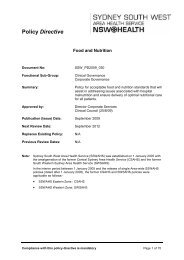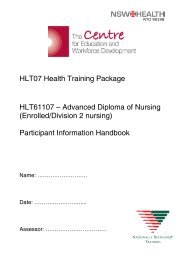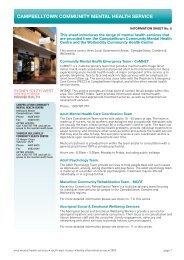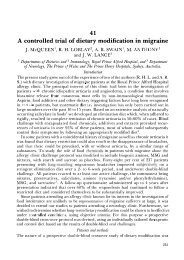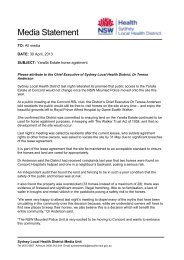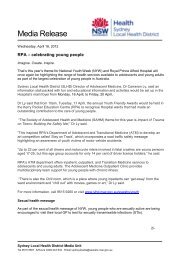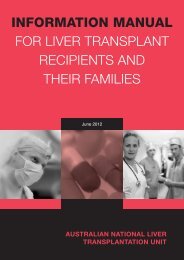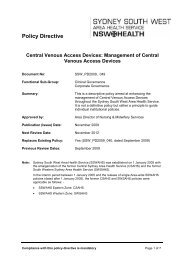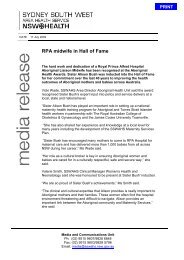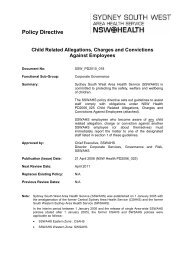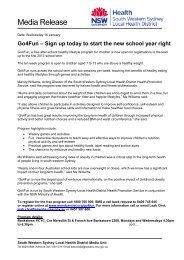Heparin and Warfarin - Sydney South West Area Health Service
Heparin and Warfarin - Sydney South West Area Health Service
Heparin and Warfarin - Sydney South West Area Health Service
You also want an ePaper? Increase the reach of your titles
YUMPU automatically turns print PDFs into web optimized ePapers that Google loves.
<strong>Sydney</strong> <strong>South</strong> <strong>West</strong> <strong>Area</strong> <strong>Health</strong> <strong>Service</strong><br />
Guideline No: SSW_GL2007_010<br />
Date issued: November 2007<br />
INR = international normalized ratio.<br />
*(use ivi formulation mixed in water, juice – see below)<br />
** If INR 2.0, (check GFR is normal –see LMW heparin protocol).<br />
1 Avoid high doses of vitamin K, where the patient will require ongoing <strong>Warfarin</strong> therapy<br />
<strong>and</strong> there is a high risk of thrombo-embolism e.g. mechanical heart valve.<br />
7.1 Blood Products<br />
• Fresh frozen plasma (FFP) 10-15 ml/kg<br />
OR<br />
• Prothrombinex-HT 25-50 IU/kg plus fresh frozen plasma (FFP) 150-300 ml<br />
(this combination is particularly suitable for patients who are unlikely to<br />
cope with a large fluid volume).<br />
OR<br />
• If FFP is not available: Prothrombinex-HT 25-50 IU/kg (usual vial size is<br />
500 IU of factors II, IX, X).<br />
7.2 Vitamin K<br />
To provide oral doses < 2 mg, use the vitamin K taken from paediatric ampoules<br />
(2 mg/0.2 ml).<br />
When intravenous vitamin K is used, because of the small risk of anaphylactic<br />
reactions, the patient should be observed for 30 minutes after administration. If<br />
the decision has been made to cease <strong>Warfarin</strong> permanently, then 10 mg IVI or<br />
orally can be given in place of the smaller doses above.<br />
References:<br />
Baker R et al. <strong>Warfarin</strong> reversal: consensus guidelines, on behalf of the Australasian<br />
Society of Thrombosis <strong>and</strong> Haemostasis. Med J Aust 2004; 181: 492-497<br />
Hirsh J et al. American Heart Association/American College of Cardiology Foundation<br />
Guide to <strong>Warfarin</strong> Therapy. Circulation. 2003;107:1692<br />
8. Patient Information on <strong>Warfarin</strong><br />
Your doctor has given you <strong>Warfarin</strong>, an anticoagulant tablet to slow the clotting of<br />
your blood. There are two br<strong>and</strong>s of <strong>Warfarin</strong> i.e. Coumadin <strong>and</strong> Marevan. It is<br />
important that you take the same br<strong>and</strong> at all times. The <strong>Warfarin</strong> tablet should be<br />
taken once at the same time each day (usually at night).<br />
Important points for Patients on <strong>Warfarin</strong>:<br />
1. Have regular blood tests for INR (the INR is a blood test to measure how quickly<br />
the blood clots)<br />
i. It is important to have regular INR blood tests to check you are taking the<br />
right dosage.<br />
Compliance with this guideline is recommended Page 15 of 24




